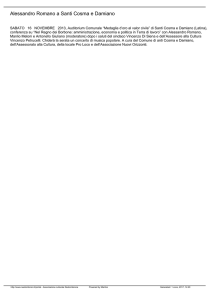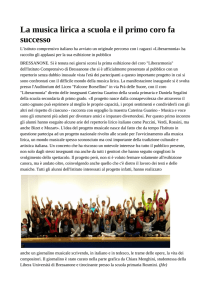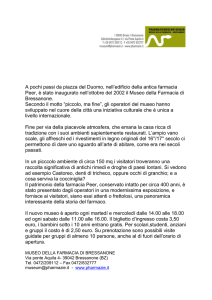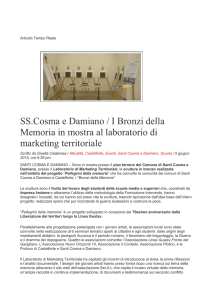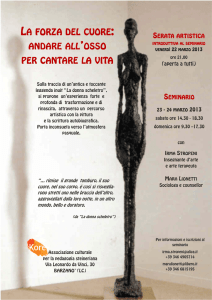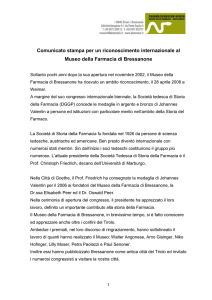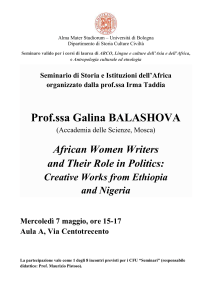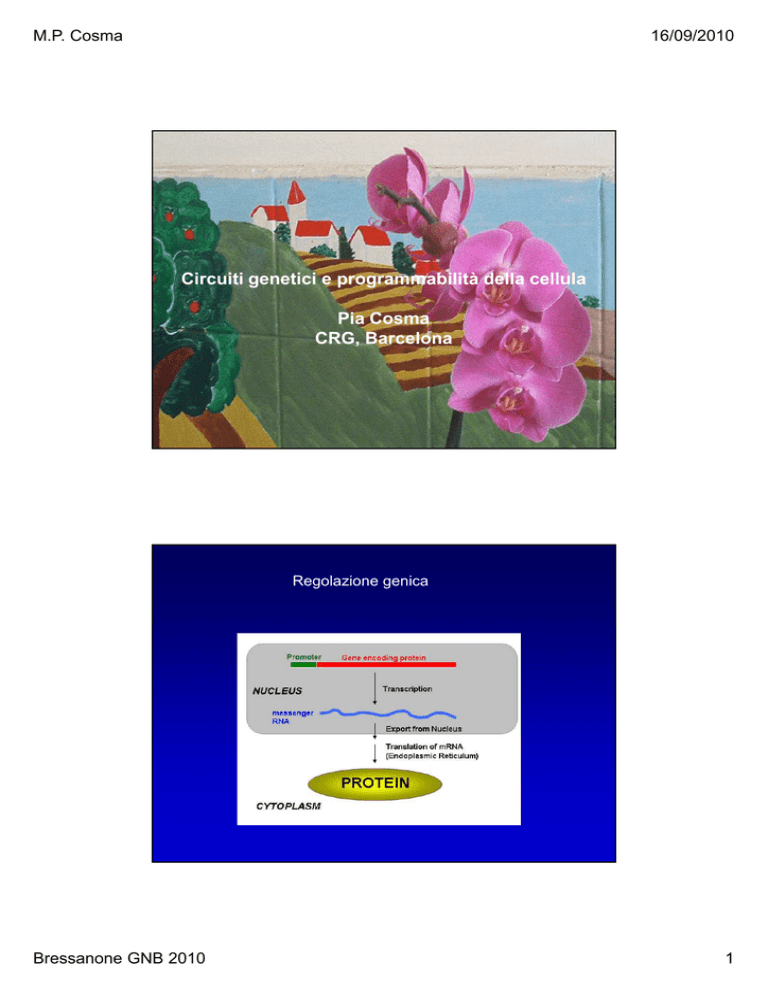
M.P. Cosma
16/09/2010
Circuiti genetici e programmabilità della cellula
Pia Cosma
CRG, Barcelona
Regolazione genica
Bressanone GNB 2010
1
M.P. Cosma
16/09/2010
I geni GAL in lievito Saccharomyces cerevisiae
G
Gal3
Gal80
Tup1
L’attivatore Gal4
Bressanone GNB 2010
2
M.P. Cosma
16/09/2010
Il dominio di legame e quello di attivazione sono separabili
Genoma del fago λ
Ciclo litico
Ciclo litico
o lisogenico
Ciclo
lisogenico
Bressanone GNB 2010
3
M.P. Cosma
16/09/2010
Il ciclo litico e il ciclo lisogenico
Lo switch da lisogenia a lisi
Bressanone GNB 2010
4
M.P. Cosma
16/09/2010
Legame cooperativo del repressore λ al DNA
C
N
Or3
Or2
Or1
Interazione di λ ai siti OR e OL stabilizza il binding e aumenta la repressione
Questo porta come conseguenza che la curva che descrive il legame del
repressore ai due siti O in funzione della concentrazione del repressore stesso
è sigmoide. E questo fa si che piccole variazioni della concentrazione del
repressore hanno un effetto importante sulla efficienza di legame al sito.
Bressanone GNB 2010
5
M.P. Cosma
16/09/2010
Domini di λ e loro impatto sulla cooperativita’ di legame
Eliminare la cooperativita’ ha lo stesso effetto di diminuire la
concentrazione dei monomeri di 100 volte
Ordered recruitment mechanism
TATA
TBP or TFIID + TFIIA
TFIIB
TFIIF-PolII
TFIIE
TFIIH
D
A
F E H
TBP B
PolII
CTD
Bressanone GNB 2010
6
M.P. Cosma
16/09/2010
One step recruitment
TATA
TBP
D
E H
B F
A
PolII
CTD
D
A
F E H
TBP B
PolII
CTD
NO GENERAL MECHANISM
Bressanone GNB 2010
7
M.P. Cosma
16/09/2010
Time
Factor ordered recruitment
Recruitment timing
Histone code
Specific cofactors
Time
Factor ordered recruitment
Recruitment timing
Histone code
Specific cofactors
Bressanone GNB 2010
8
M.P. Cosma
16/09/2010
HO
URS1
URS2
TATA
Cdk1
SWI5
URS1
HO
URS2
Late
Anaphase
TATA
SWI/SNF
URS1
URS2
TATA
Telophase
SAGA
URS1
URS2
TATA
SAGA
SBF
URS1
TATA
URS2
SWI/SNF
SAGA
SBF
URS1
SrbMed
TATA
URS2
Cdk1
G1
SWI/SNF SrbMed
SAGA
URS1
Pol II
SBF
TFIIB
URS2
TFIIH
TATA
Synthetic Biology
Biologia come tecnologia
… il punto di vista dell’Ingegneria
Bressanone GNB 2010
9
M.P. Cosma
16/09/2010
Dal lievito ad una cellula del pancreas
Telethon Institute of
Genetic and Medicine
Insulina
Ingegnerizzare
le nostre cellule per
Oscillatore in cellule
pancreatiche
produrre insulina col ciclo giorno/notte
ore
Bressanone GNB 2010
10
M.P. Cosma
16/09/2010
Creare un modello in lievito per capire i
meccanismi che governano le nostre cellule
Modello Biologico
(Dispositivi, Parti,
DNA)
Analisi e
Ricostruzione
del Sistema
Modello
del Sistema
Modello
Matematico
IRMA
A yeast Synthetic Network for In vivo
Reverse-engineering and Modelling
Assessment
Bressanone GNB 2010
11
M.P. Cosma
16/09/2010
Unravelling Gene Networks
?
Different approaches for Reconstructing
Gene Networks
Reverse Engineering
Data
Network Structure
f(x1) = a1x1 +… anxn
…………………..
f(xn) = a1x1 +… anxn
Forward Engineering (Modelling)
Predictions in untested conditions
Network Structure
f(x1) = a1x1 +… anxn
…………………..
f(xn) = a1x1 +… anxn
Targeted Experiments
Confirm Hypothesis
Validate Network Structure/Behaviour
Refine model
Bressanone GNB 2010
12
M.P. Cosma
16/09/2010
Aim of the Project
Creating an in vivo Benchmark for Testing and
Comparing different computational strategies
IRMA
(In vivo Reverse engineering and Modeling Assessment)
1) Synthetic Network Construction
2) Modelling
3) Reverse Engineering
Construction of a Gene Synthetic Network
in Saccharomyces Cerevisiae
Aim: Perfectly Known Real Network
Essential Features
• Negligible Influence from Cellular Genes (Isolation)
• Modulation of the behaviour of specific components
• Choice of Transcriptional Motifs which are peculiar of Natural Networks
Lee, TI et al. Science 298, 799-804 (2002)
Bressanone GNB 2010
13
M.P. Cosma
16/09/2010
Creating an Isolated System
How selecting genes
• Non-essential and non redundant genes
• Genes involved in different cellular pathways
• TF genes sufficient and essential to activate transcription of
a Promoter
AAAAAA
TF gene
TF
Pr gene
Key proteins that trigger HO transcription:
Swi5p
SWI genes
Swi4p Swi6p
(SBF)
Swi5
Swi5p is a zinc finger protein implicated in mother/daughter asymmetry.
It accumulates in the cytoplasm during G2 and M phases and enters in both the mother and
daughter nuclei during late anaphase. Once into the nuclei Swi5p activates transcription of
several genes: HO, CDC6, ASH1, EGT2, SIC1, PCL2, PCL9.
Swi4 Swi6
Swi4 Swi6
SBF
SBF is a tetramer containing two molecules of Swi4p and two molecules of Swi6p. It binds to
SCB elements (CACGAAA) trough Swi4p subunit.
It is responsible for the expression of HO only during late G1/S phase.
In addition to HO, SBF triggers transcription of other G1/S expressed genes like CLN1, CLN2,
PCL1, PCL2.
Bressanone GNB 2010
14
M.P. Cosma
16/09/2010
Key proteins that trigger HO transcription: Ash1
Ash1
Ash1p is a protein responsible for HO repression in daughter cells.
Its transcription is triggered by entry of Swi5 into the nucleus. It accumulates
at the end of anaphase in daughter nuclei. The asymmetric accumulation of
Ash1p is due to the activity of SHE genes.
SHE genes encode proteins needed for HO expression. She1p is involved in the
transport of Ash1p from mother cells into their growing buds.
Cbf1
MET16
MET16 encodes a phosphoadenosine-phosphosulfate reductase, an enzyme
involved in the sulfate assimilation pathway in yeast. MET16 was first identified in
a screen for methionine auxotrophs, as sulfate assimilation is required for
methionine biosynthesis in yeast. Transcription of MET16 and other genes
required for sulfate assimilation is activated in the absence of methionine. A
complex comprising Cbf1p, the transcriptional activator Met4p, and Met28p binds
to a UAS in the MET16 promoter
Bressanone GNB 2010
15
M.P. Cosma
16/09/2010
IRMA Network
Transcriptional
regulation
Cbf1
HO CBF1 GFP
Gal4
MET16 GAL4
GAL10 SWI5 MYC9
Swi5A
Protein-protein
regulation
AA
Promoter
Gene
Tag
Gal80
3xFLAGGAL80 ASH1
Ash1
2xHA ASH
ASH1
1
CH2OH
OH
O
OH
OH
OH
Galactose
Contemporarily Knock-in the new Promoter/Gene
cassette and Knock-out endogenous Genes
1
Plasmid
Promoter a
Gene b
Tag
Selectable marker
2
PCR
Promoter a
Gene b
Tag
1
Selectable marker
PCR
product
Genomic locus
Gene c
2
Recombined allele
Gene b
Bressanone GNB 2010
16
M.P. Cosma
16/09/2010
IRMA: sequential strains construction
Background
Strain
Strain 1
∆gal4
∆gal80
ASH1 locus
Strain 4
SWI5 locus
ASH1 GAL80 3xFLAG
ASH1 ASH1 2xHA
Strain 5
Strain 2
Strain 3
SHE2 locus
ACE2 locus
MET16 GAL4
natMX4
H0 locus
HO CBF1 GFP
Strain 6:
IRMA
CBF1 locus
GAL10 SWI5 MYC9
IRMA is switched on by Galactose
-RT
Cbf1
Gal4
Swi5
Ash1
Gal80
Act1
Galactose
DIC
Glucose
10 µm
Fluorescence
10 µm
Bressanone GNB 2010
17
M.P. Cosma
16/09/2010
Cell-genes controlled by IRMA are switched on
by Galactose
-RT
Pcl9
Rme1
Cdc6
Sic1
SWI5 targets
(regulate M-G1
transition)
Pcl2
Met16
Gal10
Enzymes
Act1
Perturb the system to gain
Information
Dynamic vs Static Data
Bressanone GNB 2010
18
M.P. Cosma
16/09/2010
Time-series measurements after Single Perturbation
Switch on or switch off
IRMA by changing medium
Time course
expression profiles
ON
Measure mRNA
levels at different
time points
5 switch-on Timeseries (5h every 20’)
4 switch-off Timeseries (4h every 10’)
OFF
Steady--State Measurements after Multiple Perturbations
Steady
Apply single gene
perturbation
Measure mRNA
at steady-state
Steady-state
expression of IRMA
genes after
overexpression of each
of the 5 genes vs
unperturbed status
Aim of the Project
Creating an in vivo Benchmark for testing and
comparing different computational strategies
IRMA
(In vivo Reverse engineering and Modelling Assessment)
1) Synthetic Network Construction
2) Modelling
3) Reverse Engineering
Bressanone GNB 2010
19
M.P. Cosma
16/09/2010
Steps in Model Development
Modelling approach (qualitative / mechanistic / ...) ?
Experimental data for identification & validation ?
Logical
Continuous Logical
(qualitative PLDEs)
Continuous non-linear
linear
(ODEs)
Stochastic
39
IRMA as a Benchmark for Modelling
k1
Non-linear Delay Differential Equations model
k3
CBF1
k4
GAL4
SWI5
k5
GAL80
Galactose
ASH1
k6
5 variables; 33 unknown parameters;
steady state assumption for protein levels;
nonnon-linear Hill functions to describe
transcriptional interactions;
phenomenological description of the proteinproteinprotein interaction triggered by the input;
input;
fixed time delay (100 min).
k2
Build a Formal Model (non linear DDEs)
33 unknown Parameters
Bressanone GNB 2010
20
M.P. Cosma
16/09/2010
IRMA as a Benchmark for Modelling
Measuring connection strength:
How can we measure the strength of TF on promoters?
TF + promoter
Transcritpional
complex
mRNA + promoter
If we consider
V= d[mRNA]/dt
Substrate = TF
Vmax/KM can be used to
compare promoter strength
Experimentally this means:
To express each TF at different concentrations and Measure the rate of
transcription of the target promoter
IRMA as a Benchmark for Modelling
Obtaining different levels of a TF by replacing
endogenous promoter
1
Plasmid
Selectable marker
Inducible promoter
2
PCR
Inducible promoter
1
PCR
product
Genomic locus
Promoter
TF gene (GAL4)
2
Recombined allele
Inducible pr
Bressanone GNB 2010
21
M.P. Cosma
16/09/2010
IRMA as a Benchmark for Modelling
Promoter strength: finding parameters
Met16 expression (2−∆Ct)
MET16 promoter
13 Parameters (out of 33)
were estimated
Data
Fitting
Cbf1 expression (2−∆Ct)
GAL10 promoter (in glucose)
Fitting
Gal80 expression (2−∆Ct)
Gal1o expression (2−∆Ct)
Gal80 expression (2−∆Ct)
Experimental Data
Gal4 expression (2−∆Ct)
Gal4 expression (2−∆Ct)
IRMA as a Benchmark for Modelling
Fitting remaining Parameters on Dynamic Data
Switch-on IRMA by
changing medium
ON
Measure mRNA levels
every 20’ for 5h
Glucose
Galactose
Solve Model
equation to find
unknown
parameters
Data
Fitting
Bressanone GNB 2010
22
M.P. Cosma
16/09/2010
IRMA as a Benchmark for Modelling
Test Model Predictive Power on Dynamic Data
Switch off IRMA by
changing medium
OFF
Measure mRNA levels
every 10’ for 3h
Glucose
Galactose
Data
Prediction
IRMA as a Benchmark for Modelling
Predicting Static Network Behaviour
Overexpress each gene and measure expression at steady-state
Prediction
Data
Gal
Bressanone GNB 2010
Glc
Gal
Glc
23
M.P. Cosma
16/09/2010
Aim of the Project
Creating an in vivo Benchmark for testing and
comparing different computational strategies
IRMA
(In vivo Reverse engineering and Modeling Assessment)
1) Synthetic Network Construction
2) Modelling
3) Reverse Engineering
Inference Strategies to Unravel Networks
Apply a
perturbation to
the system
Measure
mRNA levels
Learn model
t (min)
Inference
algorithm
Overexpression/Silencing
Refine Network
Local Network for the
gene of interest
Bressanone GNB 2010
24
M.P. Cosma
16/09/2010
IRMA as a Benchmark for Reverse Engineering
BANJO
ARACNE
NIR and TSNI (Gardner, et al,
(Hartemink, A. Nature
Biotechnology, 2005.)
(Basso et al., Nature
Genetics, 2006)
Science, 2003; Bansal et al,
Bioinformatics, 2006; Della Gatta et
al, Genome Research, 2008)
DYNAMIC AND
STEADY-STATE
DYNAMIC AND
STEADY-STATE (n-way)
(2-way)
STEADY-STATE (n-way)
Test reliability of the most common Reverse Engineering Strategies
ODE-based Algorithms: How they work
Linear Model (ODE)
2
6
1
9
= a2x2 + a6x6 +a9x9+ a12x12
12
an indicates the strength of
interaction between input
(gene n) and output (gene 1)
an = 0 ⇒ gene n is not a regulator of gene 1
an >0 ⇒ gene n is an activator of gene 1
an <0 ⇒ gene n is a repressor of gene 1
di Bernardo D et al Nature Biotechnology Vol.23(3) 2005
Bressanone GNB 2010
25
M.P. Cosma
16/09/2010
IRMA as a Benchmark for Reverse Engineering
Inference Results
Random PPV = 0.4
PPV (Positive Predictive Value)= Right
Connections/All Inferred Connections
Se (Sensitivity)=
Right Connection/True Connections
IRMA as a Benchmark for Reverse Engineering
Inferring Protein-Protein Interactions
Consider genes involved
in protein-protein
interactions as one
Random PPV = 0.5
Bressanone GNB 2010
26
M.P. Cosma
16/09/2010
Conclusions
IRMA: a unique tool to Benchmark Reverse
Engineering and Modelling Strategies
• IRMA:
Real system
Ground-truth known
Gold-standard dataset
Plasmid for gene single perturbation available
All proteins are tagged
In-vivo: new experimental and measurements techniques can
be tested
Small network- but can be extended
Telethon Institute of Genetics and Medicine, Naples
Irene Cantone
Lucia Marucci
Diego di Bernardo
CRG, Reprogramming and Regeneration lab, Barcelona
Bressanone GNB 2010
27
M.P. Cosma
16/09/2010
Dall’ovocita fecondato all’ individuo
Pre-impianto
2-cellule
1-cellula
8-cellule
Post-impianto
morula
blastocisti
ectoderma
endoderma
mesoderma
Cosa sono e come si isolano le cellule staminali?
zigote
ICM
Piastra di
cellule
staminali
Dallo zigote alla blastocisti
blastocisti
Una cellula staminale è:
totipotente
si propaga indefinitamente
diventa ogni cellula del nostro corpo
Cellule staminali embrionali
Bressanone GNB 2010
28
M.P. Cosma
16/09/2010
Differenziazione
si intende gli insiemi di eventi che portano alla specializzazione di una
cellula staminale in tutte le cellule dell’organismo.
Cellule staminali
Cellule
pancreatiche
Cellule
ossee
Cellule
neuronali
Beating cardiomyocytes
Bressanone GNB 2010
29
M.P. Cosma
16/09/2010
Rete di controllo dei geni responsabili del
mantenimento della pluripotenza nelle cellule ES
Tcl1
ectoderma
Pou5f1
Lhx5
Zic1
Otx1
OCT4
Hesx1
Nanog
Stat3
Nanog
SOX2
Hoxb1
mesoderma
Rex1
Sall4
Hand1
Eomes
Tbx3
Rest
trofoectoderma
Myf5
Sox2
T
Tcf3
endoderma
Dax1
Foxa2
pluripotenza
Gata6
specializzazione
Reprogramming
(increase in potency, dedifferentiation)
?
Pluripotency
Differentiation
Stem cell
Somatic Cell
Silencing of somatic cell markers
Demethylation of embryonic stem cell
specific promoters
Expression of embryonic stem cell
markers (nanog, Oct4…).
Epigenetic modifications
Bressanone GNB 2010
30
M.P. Cosma
16/09/2010
Riprogrammare in laboratorio…
Clonazione o transfer nucleare
Cellula
differenziata
clone
ovocita
Cellule staminali
Animali clonati
Riprogrammazione attraverso specifici geni Oct4, Sox2, c-Myc and Klf4
Oct4
Sox2
Myc
Klf4
iPS
Bressanone GNB 2010
31
M.P. Cosma
16/09/2010
Waddington valley
Rete semi-sintetica costruita in cellule di mammifero per teorizzare il
meccanismo di riprogrammazione cellulare
dox
dox
OCT4
SOX2
KLF4
ON
C-MYC
ON
Pluripotent genes
Sox2
OCT4 promoter
Oct4
Nanog promoter
Nanog
Nanog promoter
Bressanone GNB 2010
OFF
SOX2 promoter
Differentiation genes
ON
GFP
32
M.P. Cosma
16/09/2010
Rete semisintetica
Dinamica del processo
Il modello deterministico prevede che le cellule somatiche siano ugualmente
predisposte alla riprogrammazione verso la pluripotenza con una latenza fissa, definita
come il tempo assoluto affinché la cellula somatica origini una cellula figlia riprogrammata
positiva al marker fluorescente.
Il modello stocastico al contrario prevede che non tutte le cellule somatiche abbiano il
potenziale di essere riprogrammate con tempi di latenza diversi dovuti all’esistenza di un
rumore di fondo casuale.
Modello
Stocastico
riprogrammazione di una data cellula somatica
come un unico processo che avviene in
dipendenza del valore di una costante (k) che
indica la predisposizione intrinseca della cellula.
Le dinamiche di riprogrammazione ottenute analizzando i dati sperimentali sono
risultate consistenti con la simulazioni del modello stocastico [Hanna J et al., 2009].
Bressanone GNB 2010
33
M.P. Cosma
16/09/2010
IRMA as a Benchmark for Modelling
Predicting Static Network Behaviour
Bressanone GNB 2010
34
M.P. Cosma
16/09/2010
IRMA as a Benchmark for Reverse Engineering
Bayesian Inference Results
Random PPV = 0.4
IRMA as a Benchmark for Reverse Engineering
Mutual Information Inference Results
Random PPV = 0.7
Bressanone GNB 2010
35

